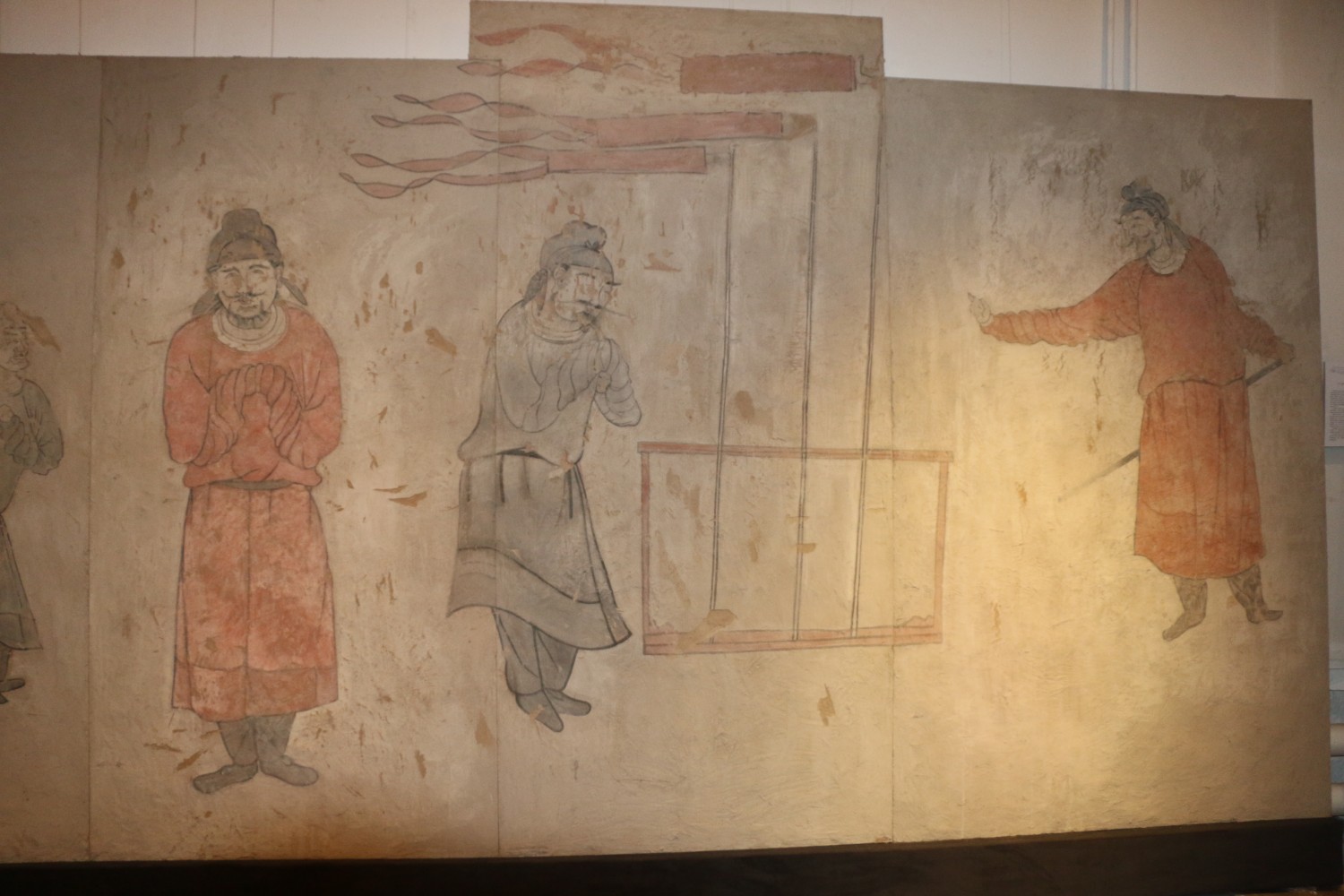Mongolian and Kazakhstan researchers joint team have done research in the Red Fort Dust Bumbagar memorial located in Bayan Nuur soum of Bulgan aimag in 2011.
The researchers concluded that the memorial tomb belongs to a noble nomad who probably lived during 7-8th centuries. Wall paintings found in the tomb is displayed at G.Zanabazar Museum of Fine Arts. The tomb consists of:
- Entrance
- Two khumugs
- Neck
- Tomb
- Ground dump on top of the tomb.
Corridor of the tomb is 43 m long and the tomb locates 7.5 m deep underground. Corridor walls have been painted with 30 paintings. Ground walls have been flattened with 0.5 cm thick batter made with grass and yellow mud, with adding another layer of liquid lime. The paint used were made of mud and colors used were red, black and blue.
Wall painting features 24 people, 1 white tiger, 1 blue dragon, 2 horses, 1 dog, 2 flags and 7 trees. It is estimated that there were at least two painters.
People, horses, dogs, temple and birds have been painted with care and none of those are similar to each other. Faces and clothes of the people described are all different. This wall painting is the rare heritage of the nomads depicting the artistic interpretation of their world view.
Before this finding the Asian wall paintings were limited by Chinese, Japanese and Korean findings, while the Red Fort Dust Bumbagar tomb has broadened the borders of the wall painting heritage up to Khangai Mountain area to the North, which brings invaluable scientific value. This tomb wall paintings prove that this heritage is not only attributable to settled nations, but to nomads as well.
Although it is hard to define to whom the Red Fort Dust Bumbagar tomb belongs, reearchers believe it might belong to the Ancient Turkic noble who lived in 7th century. Улаан хэрмийн
The display of this wall painting at the G.Zanabazar Museum of Fine Arts is to be available for the public viewing until April 22.


Mongolian and Kazakhstan researchers joint team have done research in the Red Fort Dust Bumbagar memorial located in Bayan Nuur soum of Bulgan aimag in 2011.
The researchers concluded that the memorial tomb belongs to a noble nomad who probably lived during 7-8th centuries. Wall paintings found in the tomb is displayed at G.Zanabazar Museum of Fine Arts. The tomb consists of:
- Entrance
- Two khumugs
- Neck
- Tomb
- Ground dump on top of the tomb.
Corridor of the tomb is 43 m long and the tomb locates 7.5 m deep underground. Corridor walls have been painted with 30 paintings. Ground walls have been flattened with 0.5 cm thick batter made with grass and yellow mud, with adding another layer of liquid lime. The paint used were made of mud and colors used were red, black and blue.
Wall painting features 24 people, 1 white tiger, 1 blue dragon, 2 horses, 1 dog, 2 flags and 7 trees. It is estimated that there were at least two painters.
People, horses, dogs, temple and birds have been painted with care and none of those are similar to each other. Faces and clothes of the people described are all different. This wall painting is the rare heritage of the nomads depicting the artistic interpretation of their world view.
Before this finding the Asian wall paintings were limited by Chinese, Japanese and Korean findings, while the Red Fort Dust Bumbagar tomb has broadened the borders of the wall painting heritage up to Khangai Mountain area to the North, which brings invaluable scientific value. This tomb wall paintings prove that this heritage is not only attributable to settled nations, but to nomads as well.
Although it is hard to define to whom the Red Fort Dust Bumbagar tomb belongs, reearchers believe it might belong to the Ancient Turkic noble who lived in 7th century. Улаан хэрмийн
The display of this wall painting at the G.Zanabazar Museum of Fine Arts is to be available for the public viewing until April 22.





